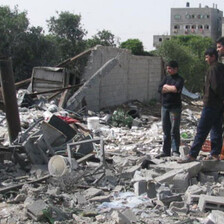The Electronic Intifada 21 March 2011
GAZA CITY, occupied Gaza Strip (IPS) - Palestinians are calling for boycotts against Israeli products and companies. But in the Gaza Strip — at the heart of the Israeli occupation — it is often impossible for residents to follow their own call to action.
The Israeli currency (the shekel) is the only monetary system in use, and Israeli products dominate key markets, particularly household items such as dairy products and detergents. Although Israel is finally allowing import of the supplies needed to produce most items locally, the four-year-long siege has taken its toll and industries must build up their businesses virtually from scratch.
“It’s been a long time under siege, and we have been a captive market,” said Sameh Nasr, executive manager of Arjan, a Gaza beverage company that participated in this month’s industrial exhibition at the Islamic University in Gaza City. “We have to educate the people that they can ‘buy Gaza’ again.”
The exhibition was the fourth such event sponsored by the Palestinian Federation of Industries (PFI), which represents about 2,000 factories in Gaza that are working to get back on their feet. In addition to the production of food both through agriculture and manufacture, Gaza has long been known for the fine craftsmanship of its furniture.
A small new hotel called The Museum — so named because of the collection of local artifacts displayed in the adjacent restaurant — recently opened, with each bedroom featuring locally-made furniture that would be the envy of artisan-loving connoisseurs anywhere.
Materials such as fine woods and a variety of metals are slowly becoming available again despite the ongoing border controls, easing the hardships that caused manufacturers such as Yassin al-Masri — whose grandfather started a furniture business thirty years ago — to scavenge among destroyed buildings for the metals he shapes into ornate designs for the frames of chairs, tables, sofas and stairways.
However, although the slight easing of the blockade has made it easier for businessmen like al-Masri to make their goods, the only market to date — due to the low income of the population — is among “elite” customers like The Museum.
The largest segment of Gaza factories is the garment industry, with between 700 and 800 production plants. It is also the hardest hit by the siege, since it was the most dependent on exports — still banned by Israel.
According to Khader Shinawra, manager of the PFI in Gaza, the garment sector of the economy employed 30,000 workers and generated sales of $8 million to $10 million per month prior to 2005, when Israel withdrew its 8,000 settlers and began imposing a blockade on the Strip.
The siege tightened still further after Hamas seized control in 2007. Today, just 2,000 employees remain at work in the industry, representing a loss of 80 percent of the companies that once helped fuel the local economy.
Ala Shak, who has worked for the thirty-year-old Gaza-based garment company Nabei al-Jawda (“quality”) for the past five years, proudly showed off his employer’s jeans at the trade exhibition, explaining that now that the blockade has lifted a little, fabrics from as far away as Germany can be obtained to make clothing of the highest caliber.
However, the cost of doing business is still high in Gaza due to the many restrictions and shortages, and he complained of a problem that Shinawra says is pervasive — competition from cheaper goods entering the Strip primarily from China and Turkey.
“It’s important to support our local businesses so we can become independent and preserve the great skill our people have,” Shak said through an interpreter. “But I know how hard it is for a family with seven or eight children to survive when locally-made jeans cost 60 to 100 shekels a pair, compared to imported ones they can buy for just 20-30.”
Even the traditional Palestinian clothing that features the intricate embroidery for which the local culture is known is too expensive for most local residents.
Shinawra said that the only way to return the economy to solid footing is for the international community to pressure Israel to allow exports once more, providing the substantial income needed to revitalize business.
In the case of agriculture, particularly strawberries and flowers, a few governments from European countries such as the Netherlands have used their diplomatic weight to pressure Israel into allowing exports during prime market seasons. However, said Shinawra, “no one has been willing to adopt our garment industry. No one is trying to help.”
As a result of this frustration, free trade has become the focus of a new generation of activists, like Jihan (“JeJe”) Alfarra, an English literature student who focuses on the topic in her blog called “Palinoia” — a merging of “Palestinian” and “paranoia” to express what she perceives to be society’s unwarranted fear of her people.
“Lots of people are trying to bring aid to Gaza, but that’s not really what we need,” said Alfarra. “We are more than capable of taking care of ourselves if we can just have control over our own borders. Gaza is great; we have such brains and talent here.”
“People work on getting out because there are no opportunities for them here right now, and when they get to other countries, they do very well. But if they could stay here and have factories of their own — just wait and see what we can do.”
All rights reserved, IPS - Inter Press Service (2011). Total or partial publication, retransmission or sale forbidden.





